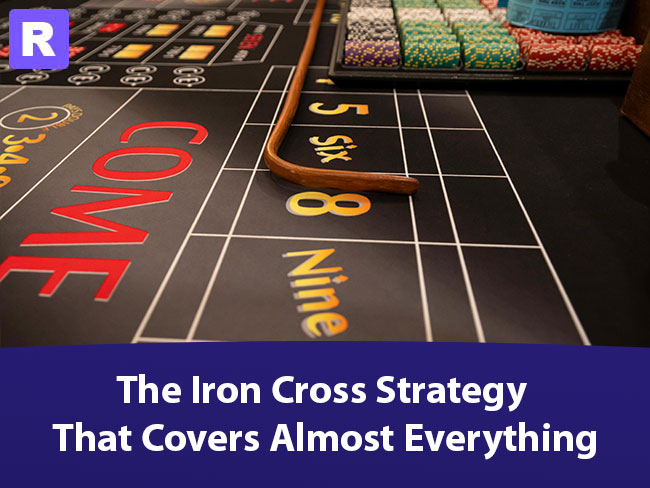You’ve probably heard craps players talk about covering the table, and the Iron Cross does exactly that—covering 30 of the 36 possible dice combinations. It’s the kind of strategy that appeals to both newcomers who want action on every roll and experienced players looking for frequent wins.
What makes this approach interesting isn’t just its coverage. It’s how it balances accessibility with complexity, offering something for players transitioning from games like slots where you’re used to frequent small payouts rather than waiting for big jackpots.
You’ll discover how four simultaneous bets work together, why the mathematics matter more than you might expect, and when this strategy, along with offers of free craps actually makes sense for your bankroll. Most importantly, you’ll understand both its appeal and its limitations—because every betting system has both.
Four Bets, One Strategy
The Iron Cross combines four specific wagers that you’ll place after a point gets established. You’re betting the Field (covering 2, 3, 4, 9, 10, 11, 12) plus Place bets on the 5, 6, and 8.
Here’s what happens when you roll.
Any Field number hits, you win that bet while your Place bets stay active. Roll a 5, 6, or 8, and that Place bet pays while your Field bet loses. Roll a 7, and everything goes down together.
The payout structure matters for your betting amounts. Place bets on 6 and 8 pay 7-to-6, so you’ll want to bet in multiples of $6 for clean payouts. The 5 pays 7-to-5, making $5 increments ideal there. Field bets typically pay even money on most numbers, though some casinos offer enhanced payouts on 2 and 12.
What you’re really doing is creating a safety net that catches almost every possible outcome. Think of it as the craps equivalent of covering multiple paylines—you’re sacrificing the potential for huge wins in exchange for consistent action.
But how do these numbers actually work in your favor?
The Math That Makes It Tick (And Where It Stumbles)
The Iron Cross carries a 1.14% house edge per roll. That’s significantly better than many single bets, but there’s more to consider.
That 1.14% figure represents what happens on each individual roll. However, when calculated to decision—meaning played until all bets resolve—the house edge jumps to 2.37%. This discrepancy occurs because Place bets are multi-roll wagers while Field bets resolve immediately.
The individual components tell the story. Your Place bets on 6 and 8 each carry a 1.52% house edge, which isn’t terrible. Your Field bet, however, faces a steeper 5.56% house edge. That Field bet drags down your overall position mathematically.
Here’s the practical reality: a 7 appears once every six rolls on average. Since the 7 kills all four of your bets simultaneously, you’re essentially betting that the shooter can avoid the most common dice outcome long enough for your smaller wins to accumulate.
The coverage looks impressive on paper. You win on 30 out of 36 possible combinations. But those six losing combinations all produce the same result—wiping out your entire position at once.
Understanding these numbers helps you decide when this strategy makes sense for your goals and bankroll.
When Iron Cross Shines
The Iron Cross performs best during what players call “hot streaks”—those periods when shooters avoid sevens for extended rolls. During these streaks, you’ll collect frequent payouts while keeping all your bets active.
This creates the strategy’s main appeal for beginners. You don’t need the massive bankroll that progressive systems like Martingale demand. You’re not waiting through long cold spells like you might with pass line only betting. Every roll except the 7 produces some kind of action.
Advanced players sometimes use “house money” progression after multiple Field wins, increasing their bets using accumulated profits rather than their starting bankroll. This approach can maximize hot streaks while limiting downside risk.
The strategy was originally designed as “hit and run”—get in, collect some wins, and get out. Energy Casino’s analysis emphasizes this point: the Iron Cross works best for short sessions rather than extended play.
That’s actually good news if you’re coming from slots, where sessions tend to be shorter and more action-oriented anyway. You’re getting the frequent engagement you’re used to with a different risk profile.
But every strategy has its vulnerabilities, and the Iron Cross has a big one.
Managing the Seven
A single 7 destroys all four bets simultaneously. That’s the Iron Cross’s fundamental weakness—you’re essentially making four separate wagers that all lose to the same outcome.
Smart bankrolling becomes crucial here. You’ll need enough to weather several 7s early in your session while giving the coverage time to work. Most experts recommend having at least 10-15 times your total bet amount available.
Consider these practical limitations:
- Don’t use Iron Cross for extended sessions—the math works against you over time
- Avoid it with tight bankrolls where losing four bets at once hurts significantly
- Skip it on cold tables where 7s appear frequently
- Remember it carries higher house edge than basic pass line with odds betting
Setting loss limits becomes more important with Iron Cross than single-bet strategies. Since you’re risking four units per decision, your money moves faster in both directions.
The strategy works better as a stepping stone than a destination. It teaches table dynamics and betting mechanics while providing the action many players crave.
Finding Your Craps Comfort Zone
The Iron Cross offers something that pure mathematics can’t measure—engagement. You’re involved in nearly every roll, collecting frequent small wins that keep the session interesting. Very similar to slot games interestingly.
Whether that engagement justifies the higher house edge depends on what you value in your gambling experience. Some players prefer the mathematical efficiency of pass line betting with odds. Others enjoy the constant action and coverage that Iron Cross provides.
Coming from slots, you probably appreciate frequent payouts over long waits for big hits. The Iron Cross delivers that familiar rhythm while introducing you to craps betting mechanics without overwhelming complexity.
The real question isn’t whether Iron Cross is the “best” craps strategy—it’s whether it matches your goals, bankroll, and tolerance for risk.


